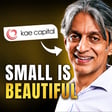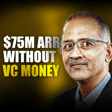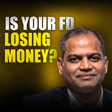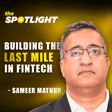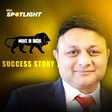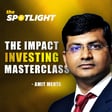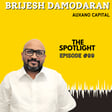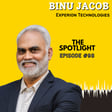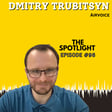Become a Creator today!Start creating today - Share your story with the world!
Start for free
00:00:00
00:00:01

Building the pipes for fintech| Rohit Taneja @ Decentro
Rohit is building an intelligent and automated platform that can provide both pre-built and customized connections for financial services. Think of it like a plug-and-play system that makes it easier to integrate with various banking and finance tools. He talks about his journey of solving deep tech infrastructure challenges in banking and financial services.
Transcript
Introduction of Guests and Episode Theme
00:00:00
Speaker
Hey everyone, this is Orit. I'm the founder of Decentral, our second time Pintec founder.
00:00:17
Speaker
It's the year 2014. Rohit Taneja has just returned to India after quitting a job with Sony in Japan. He wants to build something for India and the idea he decides to pursue is way ahead of its time. Rohit decides to build a product that would do what UPI does today.
00:00:33
Speaker
peer-to-peer payments without needing to load money in a wallet. While the startup did not succeed, this experiment of attempting to build an app that works with existing banks was so painful that Rohit's second startup Decentro is focused on solving that challenge. In this episode, your host Akshay Dutt interviews Rohit Taneja to learn about his journey of solving deep tech infrastructure challenges in the banking and financial services space.
00:00:58
Speaker
Stay tuned for the conversation and don't forget to subscribe to Founder Thesis Podcast and any audio streaming app to hear deep dive conversations with disruptive founders.
00:01:15
Speaker
I really passionate about FinTech and solving complex problems in the world, in the backyard world especially. Rohit, you are a second time founder. Let's start with your first journey of getting into entrepreneurship. Just talk to me about that phase of from ideation to actually quitting your job and getting it off the ground. Where were you when you were ideating on it and how did the idea
Rohit's Journey from Sony to Fintech
00:01:38
Speaker
come about? Just talk to me about that. In East Charles.
00:01:41
Speaker
So, I was actually in Japan at that time. I was working in a company called Sony in Tokyo. It's very much the same. So, it's always been a sort of course, really like designing, making products, taking them to market and see. At Sony, you were doing like physical product or like software? Physical products. Yeah. Hardware. Wow. Very cool. Yeah. So, I'm a hardware engineer by training. That's how I ended up in the hardware of it. You came back to my DIO? 2040.
00:02:10
Speaker
Code teachers at that point was, I wanted to solve some problems which was fairly visible to me, which I could see in my social life. For example, one of the problems is how do you share money with friends? And this is back in 2014 when UBI was out at all.
00:02:28
Speaker
So you can imagine how painful just sharing money with friends can be. Peer-to-peer payment. Peer-to-peer payments and that. Yeah. So that's the problem that pretty much every college student, millennial, every young person faces in terms of how do we, yeah, how do you simplify your social life by making sure there are no money challenges and also sharing. Of course, UBI is very simple, but before UBI we wanted the early best to actually make it happen in the market. So that's the goal of the statement was,
00:02:55
Speaker
Very personal problem statement, which I tried to solve using live word. How did you get it off the ground? Was this a regulated space back then? Like today, this payment space is highly regulated. There would be a long initial regulatory compliance work you would need to do before you can even think of starting. But what was it like back then?
00:03:17
Speaker
Yeah, I think it was just simpler. One was if there was some regulation, of course, in clicks, like, for example, you still need a banking partner in the back end to process the payments. And it also, it has to be a regulated account. For example, if you're doing collections and those kinds of things. At the same time, if you want to issue your own UPI IDs, then you need to be a UPI, right? PCS certified app. Obviously, when UPI came in, we were on the only place.
00:03:40
Speaker
So a few of these things, but otherwise it was very simple in the sense that P2P payments was fairly new thing for the country to understand. And the only regulatory instrument available except banks was wallets. Which were like faculty but people don't really like putting money into a separate wallet just for the purpose of sending it to a friend. Unless there's a different purpose that can be fulfilled. So yeah, that's essentially how the regulation works. From our perspective, I think the way we got it off the ground
00:04:09
Speaker
The first thing that we did was, of course, take a lot of market feedback. A lot of it is just, you know, something that the market really needs. It's just something that our friends need as well. And what should be the form factor? Should it be a mobile app? Should it be a website?
Developing Social Payment Solutions and Early Challenges
00:04:23
Speaker
So, I put something from those. Everything was new to us.
00:04:27
Speaker
So I did the initial coding as I came up with the initial platform when we were just three people in the team. And then we started hiring engineers and post the fundraise. The initial year was fully bootstrapped. There was nobody else in the team, just two founders and one person. And then once we launched the initial up, then that is when we started really getting traction and something like that.
00:04:48
Speaker
Okay. What did you build? Was it basically like a payment gateway? You created a payment gateway in a mobile app. Was that it with some workflows around it? What was the product? Yeah, it's not a payment gateway. Payment gateway is more for merchants. This is more like consumer to consumer. What we actually created was very cool. It was basically a social payment application.
00:05:09
Speaker
In the sense that literally, I send you money using bank-to-bank transfer. So we actually replicated the UPI without us, and I think that will be something in the future. So we were able to create a mobile number-to-mobile number transfer, which is what happens now. That's something we replicated back in 2015, using IMB as the underline protocol.
00:05:31
Speaker
And ultimately, it was a very simple social friendly app where you can just go select your friend, send money to him using any of your net banking options. And then the friend will have the option to receive the money back directly into his account. If you select a friend, how does the app know what's his account number? Yeah.
00:05:50
Speaker
Yeah, so the print has to enter. The first time he has to enter the account number. Okay. So it's like the moment you select a friend, he'll get an SMS or he'll get a link and he has to go on the link and enter his account details. Exactly. And then what? Like then you would help him log into his net banking. Like you had that integration with banks to log into the net banking and then they'll transact. Good. So on the sending side, you will use end banking or auto.
00:06:19
Speaker
Even like some of the other one, it's like 3D, my sector are like for signing mine. And then the recipient in the first time, more calls he has to register, he has to register in the back more details. Yeah. With the frequent time, the account is already marked. So just the phone number surprises. And did you have to build the pipes from your app to the net banking and all those pipes? Did you have to build them or were you able to piggyback on existing pipes?
00:06:43
Speaker
We asked a bit a lot. So, for example, if you look at the second leg, I think the first leg is collection was fairly easier in the steel clippers. We were able to wrap, say, use a pavement gateway or a
Market Strategy and Angel Investment
00:06:53
Speaker
wallet functionality. The second leg was actually much harder because we had to integrate with the banks for making spare hours directly into those backyards. What is the second leg? The second leg is when you do a repeat transaction, like when you already have the... No, the second leg is because if you look at the money flow,
00:07:09
Speaker
The way you can't send money directly from bank A to bank B, as a consumer to consumer, or rather you were not able to send this before you. And PPA is the only thing that enabled you to simplify net source. The only other protocol is I can go into my net backing, I can enter an account number and then send it. However, it's a way to come to some process because first I have to enter your account.
00:07:36
Speaker
So it's fairly dope. That's exactly what we changed by abstracting into a phone slot. How? Since ultimately, bank-to-bank IMVs is not an open APS. In the sense that a consumer is something that a merchant cannot consume or an app cannot consume.
00:07:58
Speaker
So you have to have an intermediary account, which is what? So the money has actually got submitted from the consumer aid. Before the consumer aid, it went to a central old account, which was a regulatory old student. And then from the cool account, it had to be second to the consumer. Second is where we had to interact directly with the banks. What was the need to directly interact with the banks?
00:08:23
Speaker
But you just need to work with one bank, right? The bank which holds your account. Yeah, I have. This one. Okay. So just that one bank with whom you hold the account, there you need to build automation because you would have like thousands of microtransactions. You cannot be doing it through any other way but a direct API connection. Yeah, that's great. Interesting. And what was your go-to-market for this?
00:08:53
Speaker
Oh, yeah. So I think one key benefit is we ourselves were the users of that. So the moment it came in, like the moment I saw the beta version came out, we ourselves, the team started using it. We prompted up strengths to use it as well. And there's a good wireless effect there because every time, just like WhatsApp, I added new thing. I'm able to notify them on the app saying, okay, I want a certain money with you on this for that.
00:09:17
Speaker
So every new user tries to make a couple of more users. So that's a variety, quite cheap, right? Classic industry strategies. Yeah, so I think our initial friends are grew, my college mates, my IT, my friends, those kind of things. Those were the users. And the team also, how were you funding it? Initially, we did not. Initially, it was just two founders. There was one more engineer that came, but he had a lot of bootstrap, there was not. Nobody was running it, sadly, but of course.
00:09:48
Speaker
Okay, okay. Tell me the journey from there. You then raised your angel round, right? So how did that come about? What kind of numbers were you doing at that time? Yeah, the angel round was purely on the product. Like PC round, more on the idea that this is an amazing idea that needs to exist. And definitely a backing on the team that, okay, this is a team that's like team. So it is actually from
00:10:12
Speaker
The initial need, I would say, came from Investopad, which is one of our incubators, was one of our incubators in the previous talk. So the founders of Investopad came in as engines. Didn't obviously have their own circle. With engines, that's a good thing. Once you get a couple of great engines, they automatically try to make it. At that time, I think that was the beta and maybe we had maybe around 500 users or something like that.
Scaling Challenges and Strategic Pivots
00:10:35
Speaker
Yeah, that was the core, the first round at least. Yeah.
00:10:39
Speaker
Okay, okay. To add now, to keep going on that journey, like you raised that money, how did the money change your trajectory? Yeah, absolutely. This was very small check back then. I think it was 100k. Yeah, close to 100k in USC. Not really like to see it out nowadays. If that's fair. Yeah, very small amount, which is good enough for a lean team. I only spent quite a salary or the cloud goes bang on AWS.
00:11:05
Speaker
We started hiring people. So we hired a couple of interns. We hired a couple of full-time engineers as well. We got in the design here, got a couple of developers. I think we expanded all our D to around 10 in the next one and a half years.
00:11:22
Speaker
Immediately after this ad-notch, we also entered a competition. This was Q-place. I don't think it happens on X, but this was a competition that used to happen for around three or four years at a stretch. It's basically sponsored by a couple of venture garden, who also like seed checks. And they give you a convertible note at the ground, like several
00:11:46
Speaker
Especially, it's just, I think there's no equity actually. So we actually won, we were the first price and all of that. They were fairly large and new applications, I think 500 glasses, I think, of course, India. So we were the first one for my top speed plane. And that gave us an additional 250K around, I think it's August, 2015. Yeah. Okay.
00:12:10
Speaker
Yeah, so I think with that we have more than enough cash for a couple of years. Yeah, we just started expanding on the team side and of course the product side. What were you spending on? Were you spending on customer acquisition? Yeah, we were both. Right from the platform, strengthening the status to extend the product itself, launching new versions very quickly on the application side. So the form factor ultimately was a mobile app.
00:12:39
Speaker
I wrote four, five, or second, so a bunch of those, you know, the language team as well. And yeah, customer acquisition, we were running Google ads as well to face the pace of customer acquisition. Learning from the context as well. Yeah.
00:12:53
Speaker
But the money sounds pretty small to start a payment company because at that time, 2015, that you say, I think there was this explosion of payment companies. Some of us still survive today. Some got acquired and don't survive anymore. But they were all spending on cashbacks and TV ads and holdings and so on. Did you underestimate the uphill battle of customer acquisition?
00:13:20
Speaker
Yeah, absolutely. For sure we did. I think that is one of the key things that we learned from our learning point of view that, okay, what was it that could be done differently. So I was starting that app again. I think the posting was by default. It takes a lot of time to instill that trust. Like when you're launching a new payment sample. Also, we were not positioning ourselves as a payment sample, which is a good thing. And we still don't think of it as a payment sample, even though payments was the foundation for it.
00:13:47
Speaker
The reason is because ultimately, we wanted to show it as a lifestyle. I'm going out to my friend, so I just want to strip the bill. I just strip the bill on this particular app and then send money to my friend writing. So it's as easy as sending a WhatsApp message. So the time it takes me to send you a WhatsApp message is the time that it will take me to send my...
00:14:08
Speaker
That was the messaging. That was the positioning that we had. Which worked very well. It worked in our favor. And that's what got us a lot of vitality in the market. We acquired, you know, 300,000 users. Mostly organically, without much. I think we spent five lakhs or seven lakhs in total on customer equity site.
00:14:26
Speaker
That's pretty good. Yeah. So I think that journey was pretty much going in the right direction. The problem would be of course, amazing the next shot. So how do you monetize this customer base? You didn't have any way to monetize so far. Not yet. Yeah, not at that particular point. There were a couple of ideas we have that yes, in the future, these will be a couple of ideas we could monetize. But yeah. How were you thinking about monetization?
00:14:52
Speaker
Yeah. So one was getting brands in between. So right now, for example, you are only doing peer-to-peer. We could also enable peer-to-merchant in using the QR codes. So yeah, then I could monetize from the merchant. This was when UPMDR was not zero. Right? But this would suit directly against well-funded competitors. This is what like PTM, Mobico, all of them were.
00:15:19
Speaker
If that's safe, yes. But the interesting thing was none of them were doing it on the social way. Why is Google Pay more popular than video? It does for the users now. It's because Google Pay banks to the consumer network. Okay. I like Google Pay simply because all my friends are there.
00:15:44
Speaker
I don't think of painting it when I take off my friends. I don't think, okay, it's not going to be a social app. I think it's like still a social app. Because there was chat element inside, like a chat element. That's so very vulnerable.
00:16:00
Speaker
Okay, so you had built-in the chat and... Yeah, everything was a social element of it. Yeah, I agree. I had a lingering question from how the payment works. So you said you wanted to make it as easy as sending a WhatsApp message. If I, let's say, add a number of my friend and about, say, 200 rupees to Ashok and this is Ashok's number, Ashok will get a link where he fills out his bank details. Then won't I need to manually do something to make that transaction happen?
00:16:31
Speaker
Once your friend has entered the bank details, the money will go. What about two-factor authentication?
00:16:39
Speaker
And so again, you're not conducting on a merchant, right? You're sending money to a sender, directly. At the back end, it's going to your account, right? It's equivalent. In the eyes of a bank, it would be like a merchant transaction because you wrapped it around a payment gateway. Yeah, that's correct. Exactly. So that was the next stage, right? So once we started getting into UPI is when we started figuring out, say, two entries. When you're positioning it as a P2P, the bank doesn't ask for to learn. Like even on a one end, it keeps an eye close.
00:17:08
Speaker
Okay, so once you entered the number and the user, the other user, the receiver fills out his bank details, then you are able to auto debit the account. The sender doesn't need to put in like the two-factor authentication. There's no other action needed from his side. Exactly. So while this sounds convenient, it also sounds
00:17:29
Speaker
I'm safe. Yeah, you're right. I'm sort of the trade-off between convenience and security. I think if you look at most payment apps, we'll always have that duality, right? I mean, you can either veto convenient or you're going to veto safe. You're right. But again, the fact that it's a social app, like you're sending money to us, right? Makes you famous, right? You're not, you're not interacting with the strangers.
Exit Strategy and Acquisition by PayU
00:17:49
Speaker
So that's again, the idea of, for example, why do I trust WhatsApp? Because I know who I'm chatting. Right.
00:17:57
Speaker
Yeah. You were at the point where you were thinking of raising your next round. Yeah. Tell me from there, the story from there. Yeah. Once the initial growth started coming in and once the wineries started kicking in, which was 2015, we obviously needed more cash, right? Because the idea was you need to acquire customers faster.
00:18:15
Speaker
And we did have a few challenges working out, like for example, we were giving the actual bonuses, classic acquisition strategy on the big C side. There are a couple of interesting lucky draw and those kind of things that we're running against, that we show very popular cash backs. Yeah, sort of like that. But of course, there's a money boiler, so you need to keep one.
00:18:37
Speaker
maybe a million users, which could be an inflation. So you need to figure out that inflation, where your cost of acquisition goes down. Every customer is able to get maybe at least one peak of stock. Okay, the work effects, that's good. So that was the goal. That was the goal of that year. I think we did fairly well in 2050. In 2016, we started planning for the latest. This would be probably a kind of a hit that we would have done.
00:19:05
Speaker
Unfortunately, two things happen. One, if you track bad, if you go back in grade 16, 17, you'll notice that just like the downside, now there was a downside in between.
00:19:16
Speaker
It was not as severe or as bad as today did, but it was still fairly bad. A lot of companies are not able to do this. Yes, exactly. So yeah, a bunch of things. There was a major announcement in 2017.
00:19:38
Speaker
where WhatsApp came into India and said, hey, now we're going to do our UPI. Now, if you look at it that way, WhatsApp, UPI, direct pick up the trade competitor. And that scared the investors a lot. So then they were like, okay, WhatsApp is just going to eat everybody. There won't be anybody left in the market, which has not happened, which is exactly what I told them. That is not how Indians operate. If you take over,
00:20:07
Speaker
There's a mind share of my enemy call factor that needs to be taken into account. Like when I think of patients, I don't think of what's up. I think of something else. But yeah, I think of chatting. Sure. I think of what's up.
00:20:18
Speaker
But long story short, so a lot of the investors were like, it's not ready to wait up, put in capital at point of price, and we were only going to cash from the company's perspective. So we went to the high position phase, double shock phase again for last year, which is 2017. Like you stopped spending on customer acquisition. Yeah, exactly. Stopped spending on that, stopped reduced salaries as well across the board.
00:20:43
Speaker
And then since UPN was becoming very popular, like it was taking off and they were like near the pay and they were about to make something, like phone pay, which was coming out. Pretty much every global company started getting interested in UPN. And so that is when we found a good exit alternative and okay, hey, if you're not able to raise capital, that's at least for exit. And then we started getting offers from other companies, got free offers from Amazon, PTM, and the likes.
00:21:12
Speaker
Yeah, and then they were wanting to buy you for the UPI stack. Like you had built a UPI here to build a payment app. Yeah. So I think the best software came with more features of the company than required in 2018. I've never heard of them.
00:21:28
Speaker
It's not a consumer app. So most people would not be aware. It's actually a very, very old screen company, 20 years old, more than 20 years old. What they do is they essentially power the authentication or the other 3D secure authentication for you. So the 2FA that you do. And in India, they have massive market share. I think 80% of India's e-commerce merchants are there.
00:21:50
Speaker
Well, okay. Wouldn't banks be the buyers of 2FA? Like it's the banks who? Yeah, they power the 2FA on the bank. For example, HDFC that comes to more for the MSF crisis. Yeah. Okay. Okay. Got it. Got it. So they're like a banking technology. Yes. Okay. Yeah. Got it. Okay. How much did they acquire you for? This was a little over a million dollars. Okay.
00:22:18
Speaker
So still a decent outcome for like investors who have made some money. Yes, absolutely. And this was a cash team or equity? This was a cash team stock. Okay. Okay. Okay. And then Vibmo also got acquired further. Yeah. And then Vibmo of course was in its own trajectory of growth itself. Vibmo is starting the first round in 2009.
00:22:45
Speaker
So like they didn't start having the market for like eight, nine years now. They also had plans to either go public or look for a good exit outcome for the investor that had put in capital. And hence I think P.U. came along and P.U. did a far lower value because P.U. had the frontend that they gave you, but they did not have deeper connectivity in terms of authentication services. Yeah. So they acquired. Oh, okay. Okay. Okay. Got it.
00:23:13
Speaker
So you got equity, more equity got converted to pay you equity, basically. Yeah, we got to pay you equity, which is what they were liquidating. So it's basically, they did not give up, pay you equity. They technically just liquidate everybody. Okay, got it. Interesting.
00:23:31
Speaker
And what about you? Were you still like, your startup was called My Pool Inn, right? Yes, definitely. So you continued to stay and work at My Pool Inn within Bimbo? Yeah, that is how it was done. It was basically a subsidiary acquisition. So they maintained a subsidiary at an arm's lab that, of course, continued to share some technology, knowledge.
00:23:54
Speaker
Yep. So we said there, I think 2017 is then the acquisition half. So when he, yeah, 2017, 10 is when the acquisition happened and then when 19 is that, to pay you acquisition half. Vibmo plus pay you for two, little over two and a half years, those two, three years. Yes, before starting.
Founding of Decentro and Initial Vision
00:24:10
Speaker
Okay. Okay. Got it. And was Vibmo able to give the kind of capital you needed to create a social payment company needs capital, right? Were they able to do the rest and equity?
00:24:22
Speaker
Yeah, so we asked if we would post a poster acquisition because the most key interest was more in the technology rather than less in the P2C side.
00:24:32
Speaker
So, they wanted to reuse this UPI tech stock for their own internal bubbles and the CG bubbles. So, people did not have UPI for example, at all. At the tech stock. And they also did not have yet back as a partner which was one of our partners. They brought the benefits on both of these things. Yeah, they were going for tech plus steel.
00:24:57
Speaker
Like we both wanted to get into the payment gateway business. Exactly. They wanted to build their own UPI.
00:25:06
Speaker
Got it, got it. Okay, okay, okay. So then what? What made you want to move on? It's a fairly obvious question. No foundry sticks around now after getting acquired. Yeah, yeah, yeah. Yeah, yeah, absolutely. So, obviously, the motives of scholars, scholars don't like to stay us, you know? I think the problem, or the second problem also becomes fairly evident. So I think
00:25:30
Speaker
The origin probably goes back to my pool and it's like, I always think of a lot of it. It's a foundation for you, a pathway for you to build the next one.
00:25:41
Speaker
And everything that you learn and that you've tried to break it into the next one. For example, going back to 2015, the problem that I mentioned, right? It was taking mega payouts. How do I get money from the central pool accounts down to the users? Now, in hindsight, it seems fairly separate that, okay, the bank should have an API of my MPF, which you just hit himself and you know, which is exactly how it is. But...
00:26:04
Speaker
Just integrating that single API takes you four, five months. And to my mind, that's a ridiculous number. Like I think maybe in 2014, 15, you could have that patience work. In today's age, companies don't have patience often, except six months. If I reach for six months to build a basic bike, then why isn't it a couple of hours? Talk process that I went back to that. Even after the acquisition by Beijing,
00:26:31
Speaker
My thought was, okay, five years had fallen by, we were in 2020 now, I was in 2015, I saw them. Something should have changed. But, you know, that doesn't matter now. Yeah, the dimes that it takes, even now, is the same as what you're surveying. Which is very surprising, which clearly means the banks are not looking at it, or don't want to look at it.
00:27:00
Speaker
It doesn't mean somebody else has to do it as well. But it's fairly obvious that you have some company that has to admit it out, which takes this problem of exposure to market. So again, back to the decision problem that I faced for a study as a founder and I wanted to solve it for myself, I have a little bit to take for a reason.
00:27:19
Speaker
Help me understand what kind of pipe this is. There already exist payment gateways, which are essentially pipes that help e-commerce businesses to take payments from customers. So that pipe already exists for customers to pay merchants. What kind of pipe is it that you saw was missing that you wanted to visit? That's exactly right. Yeah. So, take a look at a payment gateway. Payment gateway is related to solving one particular thing, which is payment connection.
00:27:48
Speaker
And it works for merchants basically, right? If I'm a direct merchant, if I'm selling something, sure, I can use a payment gate. But it only solves the first leg of the problem. So remember the two bifurcations which I told you. The second leg of the problem, which was, okay, I have the money now, but I also need to pay my sender or my vendor. I need to do a payout. That's something most payment gators don't. Of course, the new ones have started doing it. But it will look at the old ones like BU and all this.
00:28:14
Speaker
I'm not ready. In fact, I was the one developing. But set opinions, payouts, water. Which is also how I noticed they were still stumbling into it. So yeah, I think that was, that was the key side. Okay. Somebody used to solve the second leg as well. And more than that, companies need access to the underlying banking reasons.
00:28:34
Speaker
Directly, they can always don't want you alive or not even here. Especially if they want flexibility, like for example, if I have a market place. Now, as a market place, I might want money to be settled instantly. I don't want to wait for two days for the money to come. Maybe all my centers are waiting for the money. Or once the money comes into the center, there's probably a lender who is waiting to recover the money from the center.
00:29:00
Speaker
So that kind of a complex workflow, like money gradient from here, going out there and then going to the lender as well. That kind of a complex workflow is not something that a payment gate will look like. A payment gate will take two days to have the money hit your account. Yeah. Typically they can do faster than probably charge more. Yeah. Like a premium service.
00:29:28
Speaker
Yeah. So that was how payment gateway is made. This is the kind of APIs or other pipes, which they don't do that. The second one is more complex. So for example, if I'm building a full-fledged B2C lending application, right? That payment gateway is just a small part of it. I have to build a lot of stuff. I have to look at connecting with LendO, getting the wireless burst, doing underwriting, doing QHC. So these are the things again, which back to the APIs or back to the pipes.
00:29:59
Speaker
What all pipes can be built? Like one example, which we discussed is an IMPS pipe where you can ping your own account to do an IMPS transfer and just send it the account number and the IMPS transfer happens. So what else is there?
00:30:17
Speaker
You mean what else we have or what else can be built out? Can we build? What can we build? The possibilities are endless. There's a lot of things we haven't thought of. You have to be out of it. You had to endure a billion every time you had to make a payment. But now we've got to pay it. Somebody is able to debit money directly.
00:30:36
Speaker
without any need of duality. So that kind of thing is... You can use that not just for repayment. You can use that for subscription. You can use that for the Netflix subscription. What am I supposed to use? UPI is feeling cannibalism. UPI Autopay is live.
00:30:50
Speaker
Oh yeah, I think Autopay is live. Has been live for a long time. Okay, okay, okay. I've not really seen, like, there was this whole fracas when credit cards stopped working for recurring payments. Yeah, I didn't see any e-commerce company tell me that I can use UPI Autopay. Some of the largest merchants do, like, for example, I have UPI Autopay set for my Apple subscription.
00:31:14
Speaker
So, on my iPhone, I can just set up UBM. Even I think Google has a desktop control. There's a different challenge at UBI Automotive, which is the success rates are still in the market.
00:31:29
Speaker
Okay, got it, yeah. Yeah, I think that's one. I think you can track the latest developments, right? The UPI is now becoming... It's going to be a big pain now. That's a whole different universe, that's okay. Can I use UPI for crossword? I think we're just starting there so much.
00:31:52
Speaker
Okay, broad categories would be around payments and in different form factors like repeated regular, repeated payments and things which make multiple payments or payments based on some time-related triggers or things like that. Those are the broad kind of pipes that can be built around making payments more efficient.
00:32:14
Speaker
In fact, movements for sure, professional service is a part of it. I think credit, as I said, credit, like credit in India has been trading also and tracking it as well. Only now you're starting to see some digital lenders come into links. So yeah, I think credit is a huge credit. Okay, got it.
00:32:33
Speaker
So again, tell me that zero to one journey. You had this idea that the pipes to banks are broken or
Decentro's Growth and Product Development
00:32:39
Speaker
take a long time to build. So a company should build those pipes and make them available on tap. How did this idea get executed?
00:32:50
Speaker
Sure, absolutely. Yeah, I think once the problem signal was clear, we obviously felt certain the first thing was to figure out which bank or which partner to date. So we went back to our old friend's bank, which has made a great partner to date. They became the post-banking partner. They were very happy, of course. If you look at it from a bank perspective, it's a win-win for them.
00:33:10
Speaker
They were able to get a lot of flute as well. They were able to get more revenue as well, right? From the API side. That was the poster. I think the second one was starting to be now a team. So I started looking at, okay, who can be like engineers to help me build this? A couple of engineers joined me from the previous organization because they do work. Not happy with the large company. They were in the detail during the start of a dance, which was great. I think that really showed a lot of trust in the founder again.
00:33:39
Speaker
And then of course, I think the moment I shared that, okay, I'm going to start again, a lot of the angels definitely want to help you the second time without. So I was able to raise that angel down really quickly. I think it was close. How much did you close?
00:33:57
Speaker
This was around 300 games. Yeah. And then why you call it to happen? So I'd applied for YC for starting out officially. And then of course, YC application got accepted, which gave us a whole different boost. And then it goes another C draw, which was built to $1.7 million. Okay. And,
00:34:24
Speaker
The way you would earn would be like a few pennies for every transaction. That would be the way to do it. Yeah. So, Kubernetes are either flat or percentage depending on the kind of collections.
00:34:35
Speaker
Okay. And what kind of customers would want this kind of a banking API? Sure. Yeah. So there are only two categories, I think, at the very high levels. One is early stage wind decks, which are just starting out digitally. For example, one of the earliest customers is a fan bank. I think they're a new bank, like 14 years. Yeah. For them, it was a great foundation to window on top of. They didn't have to go around and figure out, okay,
00:35:04
Speaker
Where do I get KYC from? Where do I get X, Y, Z from? So, for all these different texts, I said, no way. I did. Like, within a matter of a month, they can literally build out their entire application and go live in the market. Which used to be one year in 2015. So, that makes difference in terms of high velocity here.
00:35:25
Speaker
That's one major category. So we have a bunch of different things. The second one is something which got on very early in the first six months. It's a larger non-printing, so that's a larger incompetence that want to add a front-end component. So for example, I think a good example here would be Jambote. So Jambote is a lot of our customers. For those that don't know Jambote, Jambote essentially runs back-end SaaS for the details. They're able to back-end logistics and all of that stuff.
00:35:54
Speaker
They're like a competitor to Iran, basically. Yeah, kind of. So now, what they wanted to do was very different. They have offered the company that want to add their own QR codes. They want to issue their own QR codes. They want to correct money through their own system. They also wanted visibility on the transactions. They also wanted to recover money from the seller for credit. That is the one. So, a bunch of mortgage works for us. So, these are Second Academy. Second Academy.
00:36:25
Speaker
Okay, got it. And like, you must have had a product journey, right? Which API did you build first and what was your go-to market for it? Just go through that journey, like you've been doing this for about three years now, right? Easy. Yeah. So let's just take me through that three-year journey. Sure. Absolutely. Yeah, I think the first step, once we had the team in place, once we had the back part, we assigned in place, was, of course, to figure out which is the first API. That is the highest in one.
00:36:49
Speaker
Mm, mm.
00:36:54
Speaker
I think the APIs that are the highest in demand, the highest in demand is payment collections. How do you simplify collections of money using payment links or UPI intent? Those kinds of things. That is the first thing. That is the first set of APIs that we built out. We also built out something called a virtual account system, which is very popular, especially in terms of easy de-constellation of money, like a marketplace or a new bank can essentially create a virtual account for every user.
00:37:24
Speaker
And then that user can deposit money into that virtual account and automatically discuss it with the account. This is the user for which money is spent. So I think that kind of reconciliation engine, that kind of simplification engine is something we built out as well. Yeah, so these are the four set of APIs. Then we entered the mall comp story in the host. We have it.
00:37:45
Speaker
One quick question. The first set of APIs on payments, how did they work? What would be the information going to a bank and what would that information trigger? Yes. Here's the bank's role, I would say.
00:38:00
Speaker
Fairly less in the sense that I tell you what's happening is the first step is you need to generate a virtual account. So let's take the case of like Jumbo Dale. Now Jumbo Dale is creating virtual accounts where everything needed him. So every detail has one virtual account and the consumer when he goes and wants to be that detail, he just needs to send money to that particular virtual account.
00:38:22
Speaker
It could be to a QR code, it could be to a PR code, it could be to... So the bad two is one, to match the money that's coming in into that account. Which they were able to do to that particular number. That's pretty much how I would say the role of the buyer and of course notifying us that okay, the money has come in and out. You've been taking the high.
00:38:56
Speaker
Okay, got it. You built that payment gateway also, through which the payment gets processed. That part, obviously, you wrap it around an existing one. This was all eight halves. All the APIs were, basically, we directly connected with the bank APIs. But there's one difference here, in the sense that...
00:39:10
Speaker
Uh, then, uh, then we'll come and say, okay, that the money has come in. Let's add it into the binding studio. That's important. And then of course,
00:39:16
Speaker
We have all those standard, as I told earlier, we don't understand the payment statement. We are very different in the form of a wide-label deep payment software gateway. As I told you, the difference in terms of the tool of APIs is something that most payment agencies won't provide. Also, we specialize in back-to-back payments. We don't do card payments. You will not find a paid card or any of these other options.
00:39:38
Speaker
Okay, interesting. How does one build a payment gateway? Does one need to go to each and every bank and integrate with them? Because the customer who's paying could be from any bank or does UPI simplify this whole thing? How does that happen? There are a lot of different components here. I think the first question to think of is if you want to build a payment gateway,
00:40:05
Speaker
I mean, what all offerings do you want to offer to the company? If you're looking at the credit card, debit card and offering, then you have to interface with the card networks. Then you have to interface with Visa or MasterCard. If you're offering something like in a banking, then yes, you have to integrate with pretty much every bank or use somebody else who else doesn't get back. But if you're offering UPI or virtual accounts like us, then you don't need to do every bank. And then you can just lie down and say, why don't you buy it to me?
00:40:34
Speaker
Okay. And these one or two banks are the banks that generate the virtual accounts for you. That's all you got to do because the payer is paying through UPI. So therefore you don't need to integrate with all the banks because yeah. Okay. Okay. Okay. Okay.
00:40:51
Speaker
Yeah. So that's, yeah. Then we are entering into the payouts. Yeah. Payouts of course, as you can imagine, do the different use cases or do it the way, which is, for example, payouts. Payouts processing is a use case. When the payouts is a use case, cashback payouts is a use case. So anywhere where the money has to go, it will get zero. Yeah. That's it.
00:41:12
Speaker
Okay. Okay. And this one again, the trigger would be an accounts number and an amount which has to be paid. That's the trigger which should go to the bank. Okay. Got it. Yeah, for those to pay out, I think these were a cool part of our payments. Then I think towards the end of 2020, we launched to KLC.
00:41:37
Speaker
Yeah, so TYT was an interesting point as well. I think this was something which I thought of way earlier on that, okay, identity verification in Excel is a huge problem. Like if I'm of intake, the first problem that I think of solving is, okay, who do I own more than who do I not own more?
00:41:53
Speaker
And how do we decide, how do we verify the identity source? So basically, we're talking about bad verification, untied verification, base match, liveliness sharing, any kind of identity, so to say. Yeah, I think giving that all under one tool and giving that as part of a very different shield or something like that came insane.
00:42:17
Speaker
How did you differentiate this? This is a fairly, this KYC as a technology stack has been around for a while. Yeah, I know. That's true. I think the key, if you look at the most KYC players, what ends up happening is after a certain point, if you are a KYC company, for example,
00:42:38
Speaker
Your target market starts saturating within a particular edition. So you have to branch out and go deep into say man's and customers. Or you have to go global. And you become a global TBC. Which is what if you're trying to also TBC companies are doing as well.
00:42:56
Speaker
So any of the regular QAC companies in your market life is not going to take hyper watch. They're more central in the US, so they're trying to get deeper into the US market. Yeah, as compared to say in your market. That's one. And second is most of the QAC companies, they typically provide you a fragmented QAC connection. So basically, it's okay. I need to stretch together multiple journeys in order to make it happen.
00:43:26
Speaker
Oh, if I'm onboarding a user, I might want to do a guarantee. I might want to do, sorry, I might want to do better than match, face match. Now, can a company stitch this together for me? Or do I need to stitch this together myself? Now, if the decision comes in.
00:43:45
Speaker
Okay. So essentially, the rent offerings are not so self-serve. Like what you're doing is like a very fillet, shut it, forget it. Yeah, that's good. Okay. So the KYC now, and that's where the positioning of the company has evolved. It started with being just relatively humid. And now it's become more broader. You know, banking is always on one end and there's pivots on the one end.
00:44:13
Speaker
Okay. Okay. Okay. Okay. Okay. Let's say you launched in 21. I didn't upgrade when you get. Okay. Okay. Okay. Okay. Yeah. Yeah.
00:44:25
Speaker
Yeah, then we moved on. I think in 2021, the key idea was just to go all in in terms of growth. And yeah, I think we do fairly well. I think in 2020, and we were there, we had probably 10 to $20,000 of monthly revenue. And by end of 2021, we were at 100k. So basically almost 10x growth of monthly revenue.
00:44:54
Speaker
Sure. And this was like on the back of your customers growing, if you, let's say you sign up FAMP Day, while initial number of FAMP Day might have been low, but they would have scaled up pretty rapidly. And so therefore your earning from FAMP Day also keeps going up. That is it.
00:45:10
Speaker
Okay. Okay. That was the key. What about adding more clients? Yeah. I think probably there's a 70-30 kind of still done where 70% of the route typically tends to come from existing customers. Okay. Interesting. Got it. Okay. Okay. Okay.
00:45:29
Speaker
Yeah, it doesn't supply me. I don't think you want to set the foundation right. Ultimately, there's a good word of mouth that heaps on screen. The company has a great god, not a platform. It's good. It's reliable. Our customers are grown by 10x in one. Just riding on the road isn't perfect. So hence, other customers want to come in together.
Funding Journey and Financial Inclusion Efforts
00:45:51
Speaker
And yeah, I think that we will continue. So that's like, I would say zero to one journey that happened. And now it's, we're already in the one to 10 phase. And did you launch more products in 2022? We did. Once the BBC was formed, the idea was, okay, how do we now go deeper into banking?
00:46:12
Speaker
For example, I think one key request that started coming from customers was, okay, you are solving payment collections for me. This will be built for me. And you're talking about it. Can you also start issuing instruments? Say, a network card. Or can you assure? No. One way up of seeing a lender in the back.
00:46:36
Speaker
Which is where the next set of modules will work. So that is how we launched the PPA cards for you. And yeah, they're very similar to payments. You just need one or two good bank providers or non-bank PPA providers. A lot of the PPA licensees weren't able to either collect money, store money, and PPA one act. And again, this is fairly lucrative business again. Especially to part spend so high, relatively you're able to earn a percentage margin here on every machine state.
00:47:05
Speaker
So this can actually generate more revenue, technically, than payments out of 10 minutes.
00:47:11
Speaker
Purely because the margin is high. But yeah, you have to get a lot of on use for it to like, you know, read it through. So yeah, I think that was the next one, the cards. Yeah, like you paid cards, there are two ways you would earn. One would be the issuance fees. Like when a new card is issued at that time, you would earn something. And then there is a merchant discount rate, one and a half to 2% out of that, some share would come to you. Yeah.
00:47:38
Speaker
Okay. Who are the customers looking for this kind of a solution? What is the use case for it? Yeah, it has two points. I think one is, there are two popular points. One is your Enzuma and your bar. Again, the likes of that bit, which obviously have their own card in the market. So all these things at some point, if they have Enzuma pacing and if they want to position themselves as a new bar, they will either have a card or an account.
00:48:05
Speaker
So yeah, that's one fast-growing, very popular use case, of course, and again, it's very much so many events now in the country. The second one is more about corporate cards, to extend management for these employees, cards, and those things, yeah. What a habit is. Yeah. Okay, okay.
00:48:24
Speaker
And these are cards which need to be loaded before you can use them. The user would need to put in money in the card. Or like in the practice case, maybe the parents put money into that card for the kids to use. That is correct. Yes.
00:48:38
Speaker
Any company using you essentially needs to have an in-house development team, right? Because you are providing tools which cut their time to launch the product to integrate those tools that need an in-house development team or be working with a development agency or something. Yeah, that's right. You're right. Today against what we're soon getting into the whole SDK or the no-code kind of environment as well. Where you're doing just embedded SDK and the SDK will do your job instead of an API.
00:49:06
Speaker
What is the difference between an SDK and an API? So what are the implications for what you just told me? The implication is your development goes down. Through an API, there's still some development required because you have to take care of all the parameters that you want to pass to the API. And you have to take a little slow on the qualifications. Thus, an API, typically, or rather, I would say, from a safety perspective, it's just your API being exposed. These are payment APIs, device APIs, so they're carrying very sensitive data.
00:49:35
Speaker
And they should not be exposed on that tab. So let's say if I am a fan payer, so fan payer uses our APIs. But fan payer does not hate our API directly from the mobile app. The mobile app will close to its fan payer, so the fan payer's server will then hate our server. That's the status we need to consume it.
00:49:55
Speaker
This is an SDK. What an SDK can do, an SDK can simplify a lot of the processing which happens on the frontend itself, for which they would have had to involve some backend developer. So, on the API, like in this scenario, I would have to involve a backend developer and a frontend developer. A frontend developer would take care of the frontend on the app, the backend would be on the API side. But an SDK, technically, I can just have one developer. I can consume it directly on the app frontend. A lot of the complexity of the processing on the backend gets possible.
00:50:27
Speaker
And will your earning change between providing API service? No. Okay. It's just going to increase adoption. Like more people will be able to adopt you if you're offering an SDK. Okay. Okay. Interesting. You raised more money also, right? After the YC, you did like a pre-series A from YC. Yeah. So we didn't seed round post-line C, including the YC capital that came in. And then we just closed YC. How much was that?
00:50:49
Speaker
No, that's the case.
00:50:55
Speaker
YC 20. Yeah, including YC, this was 1.7. Okay. And then you did a series A last year? Yeah, we did a series A last year. 4.7. Yeah.
Market Strategies and Profitability Insights
00:51:11
Speaker
Okay. And what are you using this money for?
00:51:18
Speaker
I think now it's a pure growth capital, like the zero one has done already. Now the idea is to get this flywheel in motion. How do we make that flywheel move faster? So it's basically going to feed that flywheel in terms of, you know, having more defense, like having more bank partners, be able to do better support as well. And of course, building the products that the new products I mentioned came up with. So for example, that's okay. What is the credit product?
00:51:48
Speaker
Yeah, so with the lending, it was a choice. So things which we discussed in now were more on the quieting side. And also if you look at it, the things which I told you, KYC payments and all these are all called symptoms forecast. So our companies are essentially spending money on that. They're not earning money. Now we are entering the journey where we want to enable these companies to earn money.
00:52:13
Speaker
which is where the cards have its own because, again, the two big cards are able to generate money. Same thing on credit, right? So two credit, they're able to acquire customers or get a share of the MDR as well, again, for the second two.
00:52:31
Speaker
So we don't have to leave any stream for that. Okay. Like you would allow people to give loans through an SDK. That's the goal? That's the goal. Exactly. So I think a very simple example there would be like having lipstick grandparent. Obviously grandparent has teenagers, but a lot of these teenagers want to graduate, you know, and become adults. They will want you at some point. It might be a simple BMP in line, you know, or it might be a simple person.
00:52:59
Speaker
Now, for the Ampere to invent that, they need an entire inter-switching way to get additional support. That's it.
00:53:05
Speaker
Okay, so you'll make that like a simple plug-and-play solution where typically to start a lending business you need to first find a source of capital like a lender and then you need to negotiate the rate of interest at which they will lend and then you need to build a credit and a writing engine which helps you decide whom to give a loan to. So you're building all of this through a plug-and-play solution.
00:53:34
Speaker
Yeah, some parts of it, yes. What parts of it are you doing? So, what parts are you not doing? Yeah, so we're not doing the underwriting. We're not doing decisioning for them because our belief is that decisioning varies from copy to copy. It's a very subjective and for decisioning that happens. So yeah, that's what I think. Let's start with this.
00:53:56
Speaker
So, as in you're connecting them to the source of capital also? Yes, absolutely. With a pre-negotiated rate of interest or how does that happen? Yes, that's very easy. Again, that's also subjective and the way I can't relate too much at this point. Again, it's like a new product, I would say, that we have mentioned. But broadly, think of it as a plug-in to any infrastructure where you have windows as well in the back-end and you can pick and choose which windows you want.
00:54:26
Speaker
And you don't need to deal with the lenders directly. You can choose to, but you don't need. Okay. Yeah. Okay. Interesting. Say Navi or any of these devices, VFCs, Incred, and all of them would be there. But then the rate of interest,
00:54:44
Speaker
It's not a thing for which there's a price card, that you can have a transparent rate of interest. How does that get worked out? What rate of interest which lender is charging? I think there are cases where these companies would choose to engage, which would be more frequent with the lender.
00:55:02
Speaker
I didn't say, okay, I want to revolution my own little bit too much. It doesn't, because again, our, our interest is not in terms of hyping up that rate of interest or giving a bad loan and all that. We still make money on a per APB since that's our 14.
00:55:16
Speaker
Okay, so a company which has some proprietary source of data through which it feels it can make better decision, better credit decisions, would go ahead and negotiate for a lower rate. But for other companies, it'd be like a rack rate, which is available to them. Okay.
00:55:37
Speaker
So how do you get buy-in of the lenders? Because their typical way of working would involve a lot of due diligence of the person who's coming in, which you are now just saying that anyone can plug into this API. I mean, it's like in the collections business, it's easy to give money, it's hard to take it back. Any successful lender knows that. So how do you get their buy-in?
00:56:03
Speaker
Yeah, it's not a secret again. It's a mutual thing, right? So in the sense that it's not that every vendor is exposed to every borrower. Only if this borrower and the lender have an understanding that, yes, we want to work together. That is when they work together. True reason. So that's exactly how it will happen. It won't be like, we want to say, okay, you don't want to work with this, and we'll see if we look bloody with this, and that's not how it works. That's how it's going to be, because he has to put a picture of you.
00:56:40
Speaker
You're probably in a good position to talk about what's happening in the fintech space. Like there were some recent regulatory changes because of which a lot of
00:56:50
Speaker
These BNPL companies were there. You had to pivot their business model. Can you just throw some light on what was that whole thing about your lot of BNPL and these new age credit cards, like completion credit cards had to pivot their business model. So what happened there? Yeah, it was very simple actually. So what happened is BNPL cards, which essentially were people giving loans from people in cards. That was going well from our tech perspective, but it was fairly popular for them.
00:57:21
Speaker
How did that product work? A company would say that you're getting a personal loan of one and then they would give you a card which had one lock in it. Since then, we reloaded. Yeah, that's all. So basically, it's a great line. I can draw or just play a great card. I can tap into that great line of one lock in the back.
00:57:38
Speaker
Just that it's technically not a caretaker. It's a car which is getting loaded in your time. Okay. So the moment I want to spend money from that car, I have to first on my app load money in it. You only swipe it at the back end. Okay. So fairly good toilet in fact. Because it reduces the cost of the load because you're not actually
00:58:05
Speaker
paying interest on the money until you actually swipe the card somewhere. Yeah, I think that was the construct itself. The video problem that it had rather what people observed it had was, one is it started going so popular that it overshot the adoption of it.
00:58:24
Speaker
So, to give you perspective, people were asking that there were a number of pre-bid cards on BnB were more than the credit cards for that volume or a couple of banks. Because of fintech partnerships, all these fintechs were aggressively acquiring customers. Was that the reason?
00:58:43
Speaker
A lot of these were new to grade. A lot of these were like people in the early 20s, mid 20s, late 20s. And we just wanted a small grade line of like 20,000 degrees, 25,000 degrees, all those things. So the moment that number started overshooting the grade time is when I believe that I'm going to cut the zone. That's essentially when we start to hate. We want to stop this suffering and we want it back. Okay.
00:59:10
Speaker
And what was the pivot that the BNBL companies had to do then? Yeah. So many of them are still pivoting. Technically, if you look at it now, BNBL to regulate lending or credit line is not allowed on the card. However, instead of doing a co-bounded credit card. So you can still issue a co-bounded credit card. Of course, there has to be a bank in the back end, which doesn't. So that's essentially what most BNBL companies are applying.
00:59:38
Speaker
Why? So is a credit card for a customer, is it tougher to get a credit card? Like you said that these cards shut up whereas credit cards were lagging behind. What is the reason for that? Yeah, like a credit card is more regulated as a product, so there's more KYC requirement. Yeah, it's not just in KYC, it's also about the comfort of the bank. If you look at it, you see there's more not for trade card, everybody. However, these B and B, it may as well be able to offer some sort of card. That's a good idea. Yeah.
01:00:07
Speaker
So HDFC doesn't care how many prepaid cards are issued because there is not credit risk for HDFC. Whereas a credit card is a credit risk for HDFC. It has a stricter due diligence process there. Do you agree with this? I think it was restricted. No, it's quite restricted for sure. I think they could have been a better way. I think they should have regulated it rather than banning it is what I feel.
01:00:36
Speaker
Okay. And what about create on UPI? Does that exist as a product? Not yet in the full form. There's one form that exists, which is your trade card UPI advantage. Yes, your UPI cards now have a possibility to link UPI.
01:00:53
Speaker
But yeah, I mean proper back account, backing old one, you trade on your pairs yet. Okay, interesting. We briefly spoke a bit about WhatsApp not taking off. What do you think the reason is? Is it an execution issue or is it like fundamentally WhatsApp would not take off as a payment product?
01:01:15
Speaker
Quite a few. I think one, by default, India's in regulatory terms as well as most people in India don't like foreign companies coming in and taking up their share of the market. What were the mistakes in your first startup which you are consciously avoiding in the second one?
01:01:32
Speaker
Oh, yeah. I think one was, I think not growing faster. Like we could have grown faster though. Which means obviously we should have days more we should have spent because we need that additional scalability. I think that is very important, which I've taken care of in this one.
01:01:48
Speaker
Yeah, but the second is to really ensure that you are right at the heart of that city or other ecosystem where you feel your best customers are. I think probably, for example, one which could have done it in maybe Delhi or actually Bangalore to say the city. Because Bangalore would have been probably more tech companies than Google.
01:02:11
Speaker
Yeah. So I can use up to the learnings. 12 or more and I'm one says, okay, kind of, like, like kind of investors you want, right? Those kind of things, right? Which pretty much everybody figures out the old things when we're sitting in the market. Like you want investors who can continue to fund you for subsequent rounds and things like that. Yeah, absolutely. And more importantly, you want investors who are not populating every time. Okay. What is happening? It has to be patient.
01:02:38
Speaker
Okay, interesting. So what is the way you think about growth? Is it through acquiring more customers or is it through expanding the product portfolio? Is it through increasing the pennies that you earn for every transaction? What are the ways you've thought about that?
01:02:58
Speaker
Yeah, but I think it has to boil down to the water line. I think in our case, it's very clear that we don't want to just drag vanity metrics, so it is not that we want to show a huge money flow into our system, but we're not running much on it. It has to make sense even down. So that's actually what we look at. Okay. Am I getting good enough? I don't know. I don't know this particular thing.
01:03:20
Speaker
And the margins eventually, like the good thing is as you increase your network effect, as you increase the volumes, automatically your margins increase, because you're able to drive your clock start on the providers. That's essentially how it's really key. What do you have to pay out when you build an API? Let's say you are working with the aspect to build an API for payments or for virtual accounts. What do you pay out?
01:03:48
Speaker
Yeah, it's a similar cost. So cost varies. So for example, in UPI, we don't pay anything because the banks cannot charge anything for UK collections. On payouts, yes, there's a cost per APS, but on payout, there's a cost of that. Say a few pennies for retail. And you are essentially just marking that up and charging the customer. How much do you mark up?
01:04:11
Speaker
I mean KYC will have a completely different margin structure. Overall the margin can be anywhere from 20-25% all the way up to 80-90%. Which are your most profitable products?
01:04:25
Speaker
Collections is profitable because again, technically the mind doesn't charge us on UPI, but we are able to charge the customer. Cards are also profitable with the volume, as I said, it's a question mark there.
Conclusion and Listener Engagement
01:04:36
Speaker
Yeah. These are true from a margin perspective, these two. The connections means what? Basically when a customer is paying a margin. That's right. Yeah. That's right. Okay. Okay. And so you're able to charge your customers for UPI transaction also? How is that? I thought that most customers would expect UPI to be a free thing.
01:04:55
Speaker
No, so when I say customers, which is our customer, which will come, like Jabotel, for example. Yeah. Let me speak. See, ultimately the benefit for them is you're the consolation. So finally using a payment gateway. Sure. I can bypass a payment gateway. I think of it like this. I have an e-commerce website. I was wrong.
01:05:15
Speaker
Why do I need to pay 2% to a payment gateway? I can just share my account number with my consumer. And the consumer can deposit money into that. Why do you think they don't do that? Yeah, reconsider yourself. Exactly. They're doing mediates of transactions. How will they get them reconciled? That's exactly what we saw.
01:05:37
Speaker
Okay, so any online business which has an option to pay by UPI, if they are paying for that transaction as well, the UPI transaction as well? Most of them are paying for that, yes. Okay, and what is the rate for that? A few minutes.
01:05:53
Speaker
Amazing. So few pennies or small percentage, maybe 0.5 or something like that. Interesting. How have you built up the organization? Help me understand Decentral as an organization. What is the kind of people, kind of culture? How have you done that? Sure. Yeah, I think so we are now 50 people.
01:06:23
Speaker
Within that, close to around 20 yesterday to tech product. Yeah, tech and QA actually. And there's mix of product as well, mix of business development. I would say that those in terms of the structure because we need people across the board and we need business development, of course, to handle a lot of inbounds, outbounds. I have a couple of HRs, design, marketing.
01:06:46
Speaker
First of all, access, operation. So yeah, training balance from that way in terms of tech and non-tech, yeah. What are the hierarchies in junior engineers, senior engineers, senior engineers? Okay, okay. When do you think you hit like a 1 million MRR number? 1 million MRR number, optimistically, by December.
01:07:11
Speaker
Amazing. So that's a fairly high revenue per employee at a headcount of 50ish. So that would be a pretty amazing multiple. Absolutely.
01:07:22
Speaker
Amazing. Amazing. And that brings us to the end of this conversation. I want to ask you for a favor now. Did you like listening to the show? I'd love to hear your feedback about it. Do you have your own startup ideas? I'd love to hear them. Do you have questions for any of the guests that you heard about in the show? I'd love to get your questions and pass them on to the guests. Write to me at adatthepodium.in. That's adatthepodium.in.



